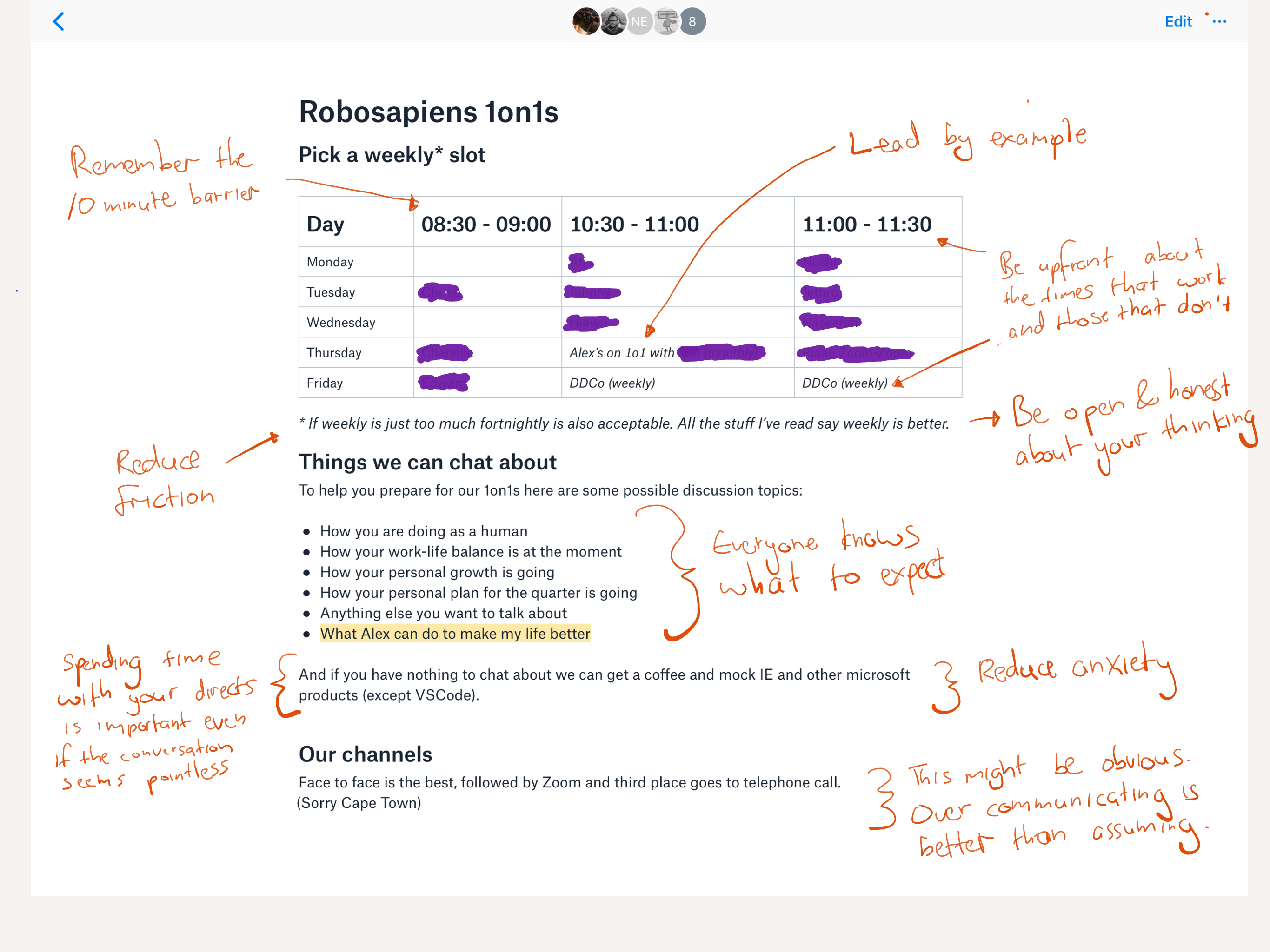I’ve been at this manager thing for a while and it’s hard. Hard but rewarding. I’ve built some high performing teams and without a doubt a key factor in my success has been 1-on-1s. When I keep to them diligently the team goes from strength to strength, and so do I. When I deprioritise them…yip you guessed it, bad things happen.
Am I awesome at 1-on-1s? Nope. Getting better at 1-on-1s has been a recurring theme in my personal development for quite some time now. I’ve learnt a ton on this journey. This guide is output of my thoughts, experiences, books I’ve read, successes, failures, feedback and everything in between. Putting this guide together has really helped me. I refer back to it from time to time. Dear Manager, I hope it helps you.
How to make time for your 1-on-1s

Building healthy and effective teams is a core responsibility of a manager. 1-on-1s are an invaluable tool in doing this. 1-on-1s generally have three purposes:
- To foster a healthy relationship between you and your direct report
- To give the two of you time to discuss things in private
- To help you develop your direct reports through mentoring, coaching and feedback.
In the wise words of Camille Fournier, author of The Manager’s Path:
“The bedrock of strong teams is human connection, which leads to trust. And trust, real trust, requires the ability and willingness to be vulnerable in front of each other. So, your manager will hopefully treat you like a human who has a life outside of work, and spend a few minutes talking about that life when you meet.”
Before you start

Before you start planning make sure you’ve got each of the following:
- A list of your direct reports
You will need to have 1-on-1s with all your direct reports. - Your calendar for the last 3 months
You will need to understand the trends in your availability and you will need to block out time for your 1-on-1s. - Your phone
You can’t remember everything so you’ll need to set up reminders
First, plan your time

Step 1: Analyse your availability
Look back at your calendar over the last 3 months. You’re looking for the no-go zones.
- Where do emergency meetings happen most often?
- Where do you feel most tired?
- Where are you liked to still be on your way if there are delays in your commute?
- Where are the scrum ceremonies?
Now that you’ve eliminated the horrible places for 1-on-1s you can move forward.
Step 2: Build the required 1-on-1 slots into your calendar
You will need one 30 minute slot for each of your direct reports.
- Start scheduling from the middle of the week outwards. Monday and Friday should not be used for 1-on-1s if possible.
- Generally speaking mornings are best. There is less time for your day to spiral.
- Try to avoid back to back slots where possible. More than two 1-on-1s in a row is unfair to both you and your direct reports.
- Select times that are likely to work from your team.
- Do not use the slots that where eliminated in Step 1.
Step 3: Set up mobile reminders
For each 1-on-1 slot set up two reminders. One well before and the other 10 minutes before. Set up the reminders on the device you are most likely to have on your person during the selected time slots.
Then, make your schedule

Step 4: Understand the components of a 1-on-1 roster
A 1-on-1 roster is made up of 3 components: Available times, Conversation Guide, Channels of communication.
Available Times
This section is built using the slots identified in Steps 1 and 2. This is where your direct reports can fill in their preferred slot. It is important that your direct reports can select their own time so that they can be held accountable for arriving on time. While you have chosen the times that work for you, you may have to adjust them based on the schedules of your direct reports.
Conversation Guide
1-on-1s can be unbelievably awkward at first. The awkwardness can discourage you and your direct report. I found that until we got used to it, the first 10 minutes were quite dry, full of operational updates or awkward. A conversation guide can be quite useful in getting the two of you through the 10-minute barrier. It allows you both to go into the conversation knowing what to expect. It is particularly important for your remote direct reports, as the distance can amplify awkwardness.
Channels of Communication
Face to face is undoubtedly the channel of communication. A prioritised list of the tools that your direct reports should use for 1-on-1s is important in case a face to face session is not possible.
Step 5: Look at this example roster
As a concrete example, here’s the roster I used with my team a while back. It worked out quite well.
The quality of our 1-on-1s improved quite a bit after its introduction.

Step 6: Build your 1-on-1 roster
You’re now ready to build your roster. Starting with the template below, customise your roster layout, copy and tone so that it is appropriate for the people you manage.
You can grab the template (Dropbox Paper) here: 1-on-1 Roster Template on Dropbox Paper
Step 7: Share your schedule with your team
Share your schedule with your team. Spend the next week or so reminding them to select a slot. Don’t be disheartened if it takes a while.
Step 8: Keep to the schedule
It is very very import that you keep to the schedule. 1-on-1s give your direct reports the confidence that they have protected time with you. This goes a long way to creating a healthy and productive team.
Lastly, change your mindset

Successful 1-on-1s require a mental shift in both you and your direct reports. Lead by example.
- 1-on-1s are your responsibility.
Because of the power dynamic it is unjust to expect your direct report to drive your 1-on-1s. - Remember habit beats willpower every time.
Show up for your 1-on-1s every time. Even if you’re late. Or can’t make the full session. Build the habit. - 1-on-1s are not status meetings.
Making status meetings out of 1-on-1s will make them dreadfully boring, repetitive and unfulfilling. - Respect the appointment.
If you can’t make it, let your direct report know in advance, if not apologise afterwards and reschedule. - Default to confidentiality.
A 1-on-1 is a safe space for your direct report, be upfront about what kind of things are not confidential. - Default to candor.
1-on-1s are an opportunity to give feedback and get to know your direct report. Open and honest communication is critical. - Be positive.
Your attitude sets the tone. Your direct report should not pay the price for the difficult meeting you just came from. - Take notes.
You won’t remember everything from all your 1-on-1s and getting to know your direct reports is important, so take notes. - This is hard.
You’re going to make mistakes; that’s okay, you’ll get better. There will be awkward conversations; that’s okay, healthy relationships can’t be rushed.

May your build always pass.
Alex
P.S. Thank you to Katerina Limpitsouni for the amazing illustrations she’s made available on undraw.co.
